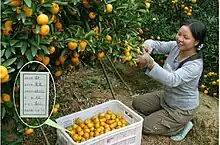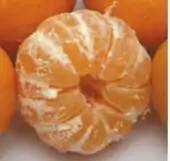Kishu mikan
The kishu mikan (Citrus kinokuni ex Tanaka) is a hybrid variety of mikan, or mandarin orange (Citrus reticulata), found in Southern China and also grown in Japan.[1] It is more closely related to the mandarin orange than to the common sweet orange.
.png.webp)
The fruit is also known as Baby Mandarin, Tiny Tangerine, Mini Mandarin and Kishu Mandarin. It is sold under the brand name "Cherry orange" in Europe. It is shaped like a mandarin, between 25 and 50 mm (0.98 and 1.97 in) in diameter. The fruit's orange skin is thin and smooth.
Some varieties of kishu,[2] such as the mukaku kishu, are seedless.[3] The species is used in creating seedless hybrid citrus.[4] The largest variety is the hira kishu.[3]
History

The fruit is thought to have arisen in Southern China; it is believed to have been grown since the 700's.[5] Its name was recorded in the records of Jianchang during the Ming Dynasty, and its agricultural growth is widespread in Jiangxi province.[6] The variety was introduced to Japan around 1200, and remained the most popular citrus in Tokyo until the 1800s.[5]
Genetic studies have found it to be closely related to the Huanglingmiao mandarin, carrying the same pomelo (Citrus maxima) introgression, indicating that the two diverged from the same backcrossed domesticated ancestor.[7] Under the Tanaka system of citrus taxonomy, it is a separate species named Citrus kinokuni, while the Swingle system groups it with other pure and hybrid mandarins as a single species, Citrus reticulata.

Kishu mikan were introduced to America in the 1800s but were not widely known.[5] A seedless cultivar was developed for commercial production starting in 1983 at the University of California Citrus Research Center, and the fruit is now commercially available at specialty markets throughout California.[8][9] It was first grown commercially in the US in the 1990s,[5] and started to be widely grown in the United States around 2010.[2]
Taste
The fruit is high in vitamin C, like other mandarins. The fruit is enveloped in a thin skin (0.11 cm or 0.043 in) and has 7–19 sections. One variety is seedless; others have seeds.[2]
Cultivation
Kishu mikan plants are small evergreen and perennial trees. They grow rapidly to a size of about 4 feet (1.2 meters) diameter and 10 feet (3.0 m) height. They are commonly planted in household gardens in Japan and additionally grown in greenhouses, balconies, and in commercial orchards.[5]
The trees require five hours of sun each day and temperatures ranging from 55–75 °F (13–24 °C). They thrive on high humidity, but require well-drained soil. Manual transfer of pollen between blossoms may improve yield.[5]
The fruit grows to 1–2 in (25–51 mm) size and is harvested in mid-winter: in the Northern Hemisphere, this is November to February, depending on the local climate. When the fruit is left on the tree for too long, it can lose its flavour. Trees may fruit in their first year and typically yield 88 lb (40 kg) of fruit annually.[5]
The fruit needs to be handled with care to avoid damage to the outer skin.
References
- http://sciencelinks.jp
- Karp, David (13 January 2010). "The Seedless Kishu, a small but mighty mandarin". Los Angeles Times.
- "Kishu". citrusvariety.ucr.edu.
- Chavez, Dario J.; Chaparro, José X. (1 May 2011). "Identification of Markers Linked to Seedlessness in Citrus kinokuni hort. ex Tanaka and Its Progeny Using Bulked Segregant Analysis". HortScience. 46 (5): 693–697. doi:10.21273/HORTSCI.46.5.693. ISSN 0018-5345.
- "The History of the Kishu Mandarin". 12 April 2022.
- Deng, Xiuxin; Yang, Xiaoming; Yamamoto, Masashi; Biswas, Manosh Kumar (2020-01-01), Talon, Manuel; Caruso, Marco; Gmitter, Fred G. (eds.), "Chapter 3 - Domestication and history", The Genus Citrus, Woodhead Publishing, pp. 33–55, doi:10.1016/b978-0-12-812163-4.00003-6, ISBN 978-0-12-812163-4, S2CID 214015638, retrieved 2023-01-18
- Wu, Guohong Albert; Terol, Javier; Ibanez, Victoria; López-García, Antonio; Pérez-Román, Estela; Borredá, Carles; Domingo, Concha; Tadeo, Francisco R; Carbonell-Caballero, Jose; Alonso, Roberto; Curk, Franck; Du, Dongliang; Ollitrault, Patrick; Roose, Mikeal L. Roose; Dopazo, Joaquin; Gmitter Jr, Frederick G.; Rokhsar, Daniel; Talon, Manuel (2018). "Genomics of the origin and evolution of Citrus". Nature. 554 (7692): 311–316. Bibcode:2018Natur.554..311W. doi:10.1038/nature25447. PMID 29414943. and Supplement
- "kishu". University of California Riverside Citrus Variety Collection. Archived from the original on 2019-04-25. Retrieved 2016-12-19.
- "Kishu Tangerine". Specialty Produce.